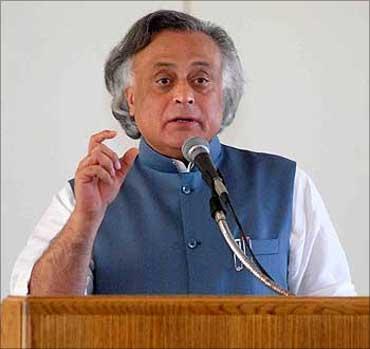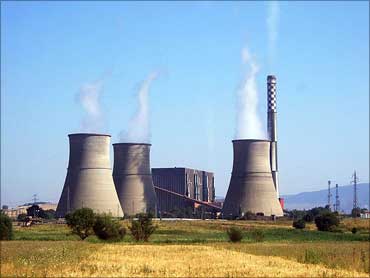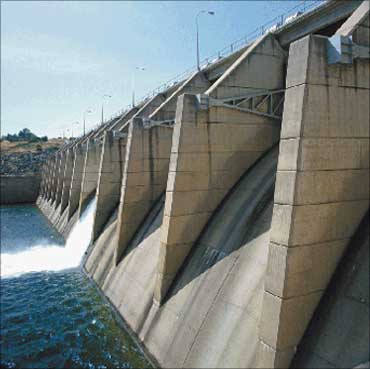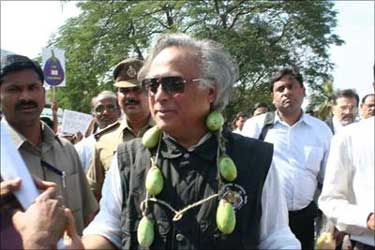
A section of industry has given him that sobriquet, but Jairam Ramesh has ensured no one ignores the environment ministry.
He has been locked in a verbal duel with at least three chief ministers and four of his Cabinet colleagues: Praful Patel, Sharad Pawar, Kamal Nath and P Chidambaram.
And, contrary to their public protestations, several industrialists are also upset about what they call Environment Minister Jairam Ramesh's activist-like positions.
"He is taking positions, which are normally associated with unreasonable activists and their organisations," says one leading industrialist whose project is stuck. It's not surprising, therefore, that in some circles, he has earned the sobriquet of 'minister for non-clearances'.
In the last 10 days, at least two high-profile companies joined the long list of those whose mega projects have come under the ministry's scanner.
Ramesh told the Rajya Sabha earlier this month that his ministry was probing alleged violation of forest laws by Posco and Vedanta in Orissa. A four-member expert group will give its report in the first week of December.
...

Data from the ministry's website show that of the 58 projects that have come up for Coastal Regulation Zone clearance since April 2009, it gave only half a dozen of them the green signal.
Over 1,800 projects are awaiting clearances as of the first week of this month.
The Environment Impact Assessment Notification, 2006, prescribes a 105-day time limit for appraisal of projects and communicating a decision after receipt of complete information. But in the case of many projects, the delays have run several months over the stipulated time.
Though the usually articulate and responsive minister did not reply to Business Standard's queries as Parliament was in session, the environment ministry says the increased number of projects in certain sectors like power and infrastructure and submission of incomplete information by project proponents mainly caused the delay.
Experts also cite several issues that go far beyond bureaucratic delays on the part of the environment ministry. For example, there are 38 tiger reserves in India covering 40,969 sq km of forest land.
There are 88 identified elephant corridors fragile narrow strips of land that allow pachyderms to move from one habitat patch to another.
India has about 100 notified national parks, 355 wildlife sanctuaries, 15-plus biosphere reserves, four coral reef areas and 34 locations identified for mangrove protection. More are in the pipeline.

India has 21 per cent of its geographical area under forest cover. According to the State Forest Report, 2009, in the last 10 years, forest cover in the country has increased by 3.31 million hectares, showing an average 0.46 per cent rise every year.
More environment preservation projects like the one for the Western Ghats are shaping up.
So, the environment ministry has no option but to say no if projects are planned within or near (around 10 km) these protected regions.
Environmental activism of non-governmental organisations, local people resisting the loss of land owned for many generations, involvement of vested interests and political interference are also major issues for project developers.
Then there is the Maoist/Naxalite opposition to many projects in several states.
"There are people who consciously instigate and organise people in coastal Andhra against projects coming up in the region," says a spokesperson of a power company, which is promoting a project in coastal Andhra Pradesh.
"Land availability is a big issue in India. Developers can approach the ministry only after either acquiring the land or have assurances to get the land, to request for the terms of reference to carry out an Environmental Impact Assessment study. By that stage, a lot of investment and time may have gone into execution of the projects, and still you are not sure of getting the clearance," says Sanjay Sethi, executive director (infrastructure) at Kotak Investment Banking.
"It is necessary to have more transparent and clear guidelines and checklists for land available for various commercial and industrial uses, with clear maps of sensitive zones, which should be easily available to project developers," he adds.
...

To be fair to the environment ministry, there are issues like misrepresentation of facts by project developers and the state, or conflicting reports on issues by expert panels.
In a recent development, the environmental clearances for at least four projects in an around Srikakulam in Andhra Pradesh were suspended by the ministry.
On July 15, the ministry cancelled the clearance given to Nagarjuna Construction Company's 2,640 megawatt (Mw) coal-based super critical thermal power plant at Gollagandi and Baruva villages in Srikakulam.
An expert panel said most of the project land allocated by the state government might be regarded as wetland, contrary to an earlier panel report that the 750 acres of grasslands were barren and not fit for agriculture.
The same expert panel, which visited East Coast Energy's 2,640 Mw thermal project near Kakarapalli village in Srikakulam during the same time, found the state government had ignored reports on the ecological value of low lying areas of the well recognised Naupada swamps wetland and migratory bird breeding in nearby Telineelapuram of Srikakulam.
"This amounts to suppression/distortion of facts," the panel said.
A nearby project - that of JSW's 1.4 million tonnes per annum (MTPA) alumina refinery and a co-generation plant - is also being reviewed by the ministry.
A panel has recommended the ministry to consider issues like depletion of water in present perennial streams feeding a reservoir in the vicinity and pollution of water sources before giving the forest clearance for bauxite mining.
...

On June 28, the ministry directed the formation of a supervisory committee to monitor the influence of toxic effluents from JSW Energy's 1,200 Mw thermal power plant at Jaigad in Maharashtra, following apprehensions that effluents could affect the quality of Alphonso mangoes and cashew orchards in the region.
JSW Energy will have to spend 527 crore ( 5.27 billion) to set up an effluent system and if the toxins are still beyond the permissible levels, it will have to either close the plants or change the fuel.
Ten days before that, Jindal Power Limited drew the wrath of the ministry for commencing construction of a 2,400 Mw power project at Tamnar in Chhattisgarh, without obtaining prior environment clearance.
The ministry has directed the state government to stop work and initiate action against the Naveen Jindal-promoted company.
Some of the other high-profile projects that have been halted include the Maheshwar Hydroelectric project on the Narmada river in Madhya Pradesh on grounds that the conditions of the statutory environmental clearance were not complied with and the resettlement and rehabilitation of the project-affected families was less than satisfactory - charges denied by the state chief minister and the company.

However, it has certainly not been roses all the way for Ramesh. The government has given a go-ahead for partial work to resume on the Maheshwar dam, despite the ministry's recommendations.
Also, many say the minister has involved himself in much-publicised wars of words with Civil Aviation Minister Praful Patel over the environment ministry's reluctance to clear the Navi Mumbai international airport, citing destruction of mangroves, razing of a hill and diversion of two rivers; with Road Transport Minister Kamal Nath, who openly accused him of blocking projects; with Agriculture Minister Sharad Pawar over Bt brinjal; and, of course,with Home Minister P Chidambaram, who was upset with his comments on how the home ministry had taken an alarmist view on China, something for which Ramesh had to apologise.
But, even his sharpest critics agree on one thing: Ramesh has made sure that no one can treat the environment ministry lightly any longer.
Magsaysay Award winning social activist Sandeep Pandey says earlier projects used to go on without environmental clearances or conditional clearances that were never honoured.
"This is probably the first time that an environmentalist has become a minister. He is almost single-handedly bringing about a paradigm shift within the government about how to view progress and development," says Pandey.
...